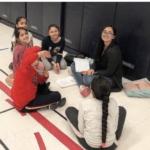
Many friends across Ontario are thinking about systems that “support learning in action by an increasing number of participants in neighbourhoods and villages.” [1] Friends in the Oxford-Perth cluster have been naturally supporting the Huron-Bruce cluster and working towards growth in both clusters is integral to their vision.
The Ottawa cluster has also been learning about this flow of insights over recent years, both between Ottawa itself and outlying areas such as Cornwall and Arnprior, as well as amongst teams in the city. Here, one can discern the mode of learning characteristic of advanced clusters, which: “permeates the whole community and acts as a spur to the rise in institutional capacity. Accounts that offer insight into a method, an approach, or a complete process continually flow to and from pockets of activity.” [2]
A number of neighbourhoods in Ottawa are not only moving towards their own goals, but have recently begun sharing their learning amongst neighbourhood teams. At this time, the neighbourhood of Greenboro-Heatherington has 183 core activities, engaging approximately 600 participants. Members of the nucleus have been getting together with other nuclei working towards 100 activities. It’s been a space to share questions about what’s next as well as key insights. With this pattern over the summer one neighbourhood doubled in activities going from some 30 to 60.
A few stories from the Springdale neighbourhood in the Brampton cluster shed light on the way the House of Justice describes the emergence of a culture which:
“…promotes a way of thinking, studying, and acting, in which all consider themselves as treading a common path of service, supporting one another and advancing together, respectful of the knowledge that each one possesses at any given moment and avoiding the tendency to divide the believers into categories such as deepened and uninformed is an accomplishment of enormous proportions.” [3]
In addition to the spirit of accompaniment present amongst this expanding nucleus, the following accounts shed light on how seeing the growth of others as linked to our own progress can lead to “the dynamics of an irrepressible movement.” [4]

Over the past year, the Brampton team has invited youth from Waterloo, Guelph, Niagara, Peterbourough and Rowntree to join their expansion phases and other campaigns. Martharoot Malungu describes how bringing someone new into the pattern of your cluster or visiting theirs, naturally brings about opportunities to explain and thereby strengthen “what you’re doing and why”. The connection between the Waterloo and Brampton teams was potent when both went into the second lockdown of the pandemic. Friends were texting one another, describing their longing for a space, something that could uplift and support their efforts during that difficult time. They decided to simply bring their teams together to reflect, drawing on Reflections on Growth. Martharoot describes how the study opened them up to sincere consultation:
“We were realizing we didn’t know what to do; we didn’t know how to navigate our new reality. There was this comfort in knowing that we all don’t know what we’re doing right now and we’re all just trying our best to put the guidance into action. Both teams reflected on the things they had been learning about and tried to think of how the strengths accumulated over time would guide their movement forward. .. Before this gathering, one junior youth coordinator had been thinking, ‘I’m the worst coordinator’ but hearing that others were also trying to see their next step was really helpful. We left that gathering with the conviction that consistent efforts would lead to insights on how our teams would continue to operate.”
Those serving as children’s class teachers in Brampton were later invited to a sub regional gathering hosted by the Waterloo team to reflect on the learning generated around offering classes at this time. Martharoot invited another youth from the neighbourhood to join her for this meeting Martharoot describes how her collaborator from the neighbourhood texted her during the meeting, saying she was nervous to contribute her thoughts and experience and didn’t think they would advance the conversation. With some encouragement, she answered and drew beautifully on her experience in the field. Martharoot describes: “I remember she said to them, ‘I hope you don’t think this was easy! We struggled for a bit to arrange ourselves and I found it really hard. We met every single day for an hour.’ She was very realistic about it, not just making it sound beautiful to encourage people. Afterwards, she shared with me privately:
‘I never ever thought that the things we are learning are this important. These questions they have are real questions…but when we’re doing it, we just do it and hope for the best and pray to God. But when they were asking questions and listening to our answers, it reminded me that what we’re doing is important. We have to write this down! The children’s class teachers need notebooks! They need to track their learning.’”

It is in these spaces, that an additional layer, not only of learning, but of ownership of the process, seems to occur. Perhaps this aspect of true accompaniment reflects the way the impact of pioneering, not only for the communities that benefit from these souls’ contributions but for those who arise and their ‘home’ clusters: “In time, they return to their communities much inspired and enriched, able to contribute even more effectively to the advancement of their own clusters.”[5]

Sharing insights between localities can often lead to the “tendency to reduce a complex process of transformation into simplistic steps, susceptible to instruction by manual.” [6] Upon hearing how the collaborators in Rowntree were connecting to junior youth through offering handmade booklets on their home visits, coordinators from Brampton immediately wanted to adopt this same practice. However, they found the junior youth in their community were resistant to the idea and had other inclinations of how they could best connect with their friends. In the end, the visits were carried out as the junior youth themselves had envisioned. In fact, one junior youth beautifully sang a quotation to his friend’s whole family, in their home, right before the pandemic. What comes through in this story is also the spirit of learning and experimentation. Martharoot reflects that:
“It’s not a big deal to make these mistakes to learn. It’s not about the ‘best idea’ but about this openness to always learn. We’re learning that accompaniment isn’t “I share this experience with you about what’s worked and you go repeat it; it’s more about listening and encouraging, asking ‘what have you done? What insights have come from that action? And how can those insights lead to next steps?’”
In addition to seeing the importance of spaces for reflection, the spirit of searching consultation described above highlights how articulating one’s learning brings about unique realizations and reinforces dedication to one’s path of service. It calls to mind these stirring words from the Universal House of Justice:
“In relationships among the friends, then, this development in culture finds expression in the quality of their interactions. Learning as a mode of operation requires that all assume a posture of humility, a condition in which one becomes forgetful of self, placing complete trust in God, reliant on His all-sustaining power and confident in His unfailing assistance, knowing that He, and He alone, can change the gnat into an eagle, the drop into a boundless sea.” [7]
[1] Universal House of Justice, 28 December, 2010
[2] Universal House of Justice, December 29, 2015
[3] Universal House of Justice, Riḍván, 2010
[4] Universal House of Justice, Riḍván, 2010
[5] Universal House of Justice, 23 May 2016
[6] Universal House of Justice, 28 December 2010
[7] Universal House of Justice, Riḍván 2010


